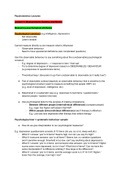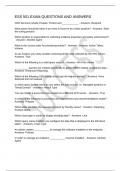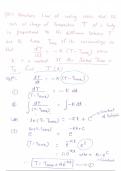Lecture 1: Measurement, Scaling, and Norms
Measuring psychological attributes
Psychological construct (e.g.intelligence, depression)
- Not observable
- Latent variable
Cannot measure directly so we measure what is influenced
- Observable behaviour
- Need to have operational definitions (ask complicated questions)
Use this observable behaviour to say something about the (unobservable) psychological
construct
- E.g. degree of depression ---> response to item ‘i feel sad’
- Try to determine degree of depression based on OBSERVABLES / BEHAVIOUR
(e.g.responses to questionnaire items)
- Theoretical leap / discussion to go from unobservable to observable (is it really true?)
● Test of observable contract depends on observable behaviour that is sensitive to the
psychological construct (want to measure something that people VARY on)
(e.g. level of depression, intelligence, etc)
● Determined in a systematic way (e.g. responses to test items / questionnaire /
observe people / reaction time test)
● Use psychological tests for the purpose of making comparisons
- Between different people (interindividual differences) (compare people)
E.g. roger has higher self esteem that Raff
- Within people (intra-individual differences) (see if therapy is effective)
E.g. Lola was less depressed after therapy than before therapy
Psychological test = systematic behaviour sample
● How do we give interpretation to our psychological measures?
E.g. depression questionnaire consists of 10 items (do you cry a lot, sleep well,etc)
- What if: I answer ‘yes’ to 9 items? Seems high, but can you say it's high?
- What if: everyone answers ‘yes’ to all items? Seems low, no variation (questions
aren’t sensitive enough, threshold is too low, can't say anything about depression)
- What if: I answer ‘yes’ to 4 items, and someone else answers ‘yes’ to 8 items? Higher
scores seem more depressed, but is it true? What kind of items? Can we have the
same interpretation? Is difference arbitrary? How large is the difference?
- What if: I answer ‘yes’ to 5 items, and the average score is 2.3? Or 5.6? Higher /
lower than the average, how high / low?
, - You need a REFERENCE, INSURANCE OF CONTENTS, AVERAGE, SPREAD,
NUMBER OF SCORES
Scaling
- The way numerical values are assigned to psychological attributes
- Process of assigning numerals to the psychological attribute (to arrive at test score)
- How is a test score or category determined from the observables? (e.g. item
responses?)
- What values do you give to categories and what is the interpretation of values in
relation to the psychological attribute?
Properties of numerals ↔ measurement level
- Determines how we can use numerals for calculations
Scales of Measurement
Measurement Level Property of Numerals
Nominal Identity
Ordinal Identity and Order
Interval Identity and Order and Quantity
Ratio Identity and Order and Quantity and
Absolute zero
- Identity, it should be exhaustive and exclusive (select only 1 category, at least 1)
- Interval, unit of measurement
- Ratio, has to have ALL of the properties
- Determine kind of calculations you can do with scores
Interpretation of test scores
● Test: systematic behaviour sample
E.g. set of 10 self-response items (score 1-5)
● Scaling: assigning quantitative test score
E.g. sum of item responses (10-50)
● Norming: interpretation of test scores (use a reference to group / absolute norm)
E.g. James scores 22. What does that mean?
➔ How does james’ score of 22 compare to:
- Scores of relevant others? ---> RELATIVE NORMING
- To a fixed standard? ---> ABSOLUTE NORMING
, ● Distribution of test scores
- What information does it give?
● What is the meaning of James’ creativity score of 22?
- Depends on distribution (reference group matters, can give interpretation)
- Even if the mean is the same, spread may differ
- Standard deviations used to calculate z score
Standard score Z
● Number of standard deviations from the mean
● Both positive and negative values (positive = above mean, negative = below mean)
● Mean = 0, SD = 1
Z = specific score - mean of distribution / standard deviation of distribution
1) James Z score: (22 - 25) / 1 = -3
- So he scores 3 SD below average
2) James Z score: (22 - 25) / 5 = -0.6
- So he scores 0.6 SD below average
What does the standard deviation mean?
● We assume all psychological constructs follow a normal distribution
- Most people would fall around the mean
- Meaningful for giving interpretation of how extreme a score is
- Used also for outlier detection
, Is a standard deviation of 1 intuitive? Is it easy to interpret? Should we use different standard
deviations?
Converted Standard Score Tx
● Easier to understand / ‘friendlier’ than Z-scores
● Only positive values, has no zero or negative values
● Mean = 50, SD = 10
T = 10 x Z-score + 50
1) James T-score: 10 x -3 + 50 = 20
- Scores lower than the average
2) James T-score: 10 x -0.6 + 50 = 44
- Quite close to the mean
Percentile Ranks: Px
● Percentage of scores that are below or equal to a specific test score
- E.g. for X = 10, the percentile rank is the percentage of people with score 10
or less = up to and including 10
Conversion X ---> Px
Use frequencies of test scores (how many people have a kind of test score)
● Relative position of score X
● In ordered distribution of observed scores (how many of total sample have this score
or lower)
● = cumulative frequency of score X
E.g.
Score Frequency
0 20
1 20
2 20
3 20
4 20











